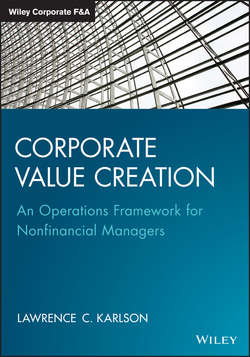Читать книгу Corporate Value Creation - Karlson Lawrence C. - Страница 24
На сайте Литреса книга снята с продажи.
CHAPTER TWO
The Envelope Equations 28
⧉ NI and CFaIA – The General Model
ОглавлениеThe preceding section provided a progressive year-by-year development of a year-specific set of the Envelope Equations that can be used to predict Net Incomes and Cash Flows for such things as a first cut at a multiyear business plan. The rigor involved is probably adequate for most readers. However, there are always those who also like to see the general treatment or at least would like to have it available for reference. The equations for Year n and Year n + 1 will hopefully be familiar since they have been derived in detail in the preceding sections. The equations for Years n + 2 and so on are the subject of Appendix D.
If NIn is the Net Income for Year n in a company that has a Net Investment Rate of IRn and a Net Income Return on Capital Employed of NiROCEn, then in Appendix D it is demonstrated that:
For Year n
Net Income in Year n = NIn
[2-8]
Net Invest n NetInvestn = (NIn)(IRn)
[2-16]
Cash Flow n CFaIAn = NIn − NetInvestn ± NetIntn ± ΔWCn
[2-18]
Or CFaIAn = (NIn)(1 − IRn) ± NetIntn ± ΔWCn
For Year n + 1
[2-15]
Net Invest n + 1 NetInvest(n + 1) = (NI(n + 1))(IR(n + 1))
[2-12]
Net Income n + 1 NI(n + 1) = NIn + (NetInvestn)(ROCE(n + 1))
[2-14]
Or NI(n + 1) = (NIn)[1 + (IRn)(NiROCE(n + 1))
Cash Flow n + 1 CFaIA(n + 1) = NI(n + 1) − NetInvest(n + 1) ± NetInt(n + 1)
[2-31]
± ΔWC(n + 1)
[2-32]
Or CFaIA(n + 1) = (NI(n + 1))(1 − IR(n + 1)) ± NetInt(n + 1) ± ΔWC(n + 1)
For Year n + 2
[2-33]
Net Invest n + 2 NetInvest(n + 2) = (NI(n + 2))(IR(n + 2))
[2-34]
Net Income n + 2 NI(n + 2) = NI(n + 1) + (NetInvest(n + 1))(NiROCE(n + 2))
[2-35]
Or NI(n + 2) = (NI(n + 1))[1 + (IR(n + 1))(NiROCE(n + 2))]
Cash Flow n + 2 CFaIA(n + 2) = NI(n + 2) − NetInvest(n + 2) ± NetInt(n + 2)
[2-36]
± ΔWC(n + 2)
[2-37]
Or CFaIA(n + 2) = (NI(n + 2))(1 − IR(n + 2)) ± NetInt(n + 2) ± ΔWC(n + 2)
and so on.
The discussion in Appendix D of these equations makes it clear that the equations that were derived did not place any restriction on what the Investment Rate and Net Income Return on Capital Employed must be in any year or relative to any other year. In other words, they are completely general.
Special Case: Constant Investment Rate and Net Income Return on Capital Employed
Earlier it was mentioned that over time IR and NiROCE often tend to be relatively stable. Therefore, in situations where the Investment Rate and/or Net Income Return on Capital Employed don't change from year to year, the subscripts on these terms can be dropped and they can be treated as constants. It's possible to restate Equations [2-8], [2-16], [2-18], [2-15], [2-12], [2-14], and [2-31]–[2-37] with IR constant and NiROCE variable, IR variable and NiROCE constant, and both IR and NiROCE constant. See Appendix D for details.
Special Case: Focus on Operational Cash Flows
The equations in the “General Model” deal with Operational Cash Flows as well as Interest (Capital Structure) and Changes in Working Capital (Balance Sheet). In some situations the impact of Interest and Changes in Working Capital can be ignored. Here are some of the considerations.
±NetInt: The amount of debt a company takes on is a function of its capital structure and in the final analysis this is decided by the owners of the business (shareholders) via the board of directors. In practice, however, the CEO and his management team are responsible for everything that happens in a business. Therefore the management team can't get a free pass and hide behind the board of directors when it comes to capital structure. Stated simply, they have to deal with the hand that has been dealt and improve it over time and provide sound proposals for financing growth.
Конец ознакомительного фрагмента. Купить книгу
